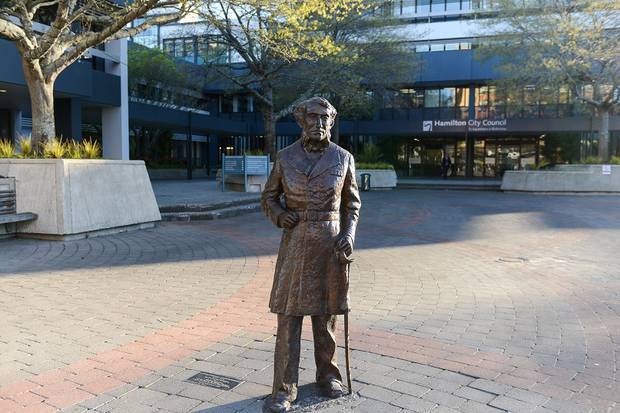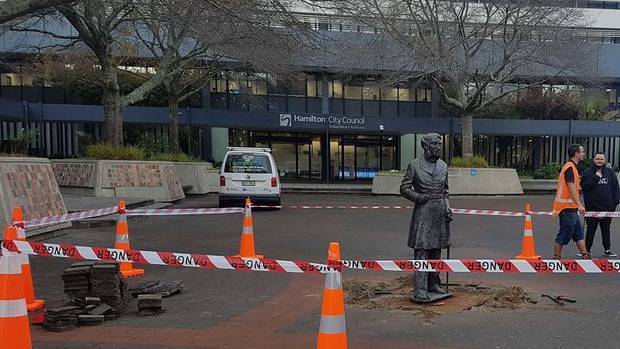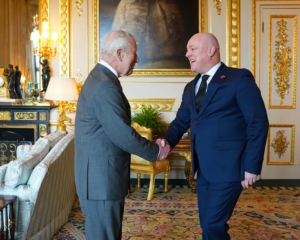
The move comes after a formal request to remove the statue of Captain Hamilton from iwi Waikato-Tainui on Thursday, amid a growing international drive to remove statues which are seen to represent cultural disharmony and oppression.
The bronze statue of Captain John Fane Charles Hamilton was originally gifted to Hamilton City by the Gallagher Group in 2013.
Hamilton was a British officer who led a detachment of the 43rd regiment at the Battle of Gate Pā against Māori in Tauranga during the New Zealand Wars. He died during that battle in 1864.
He never set foot in the city that took his name.
In 2018 Huntly's Taitimu Maipi vandalised the statue in protest at Hamilton being named after the British captain who killed Māori in the Waikato land wars.
He also called for the city to itself of the colonial title and be renamed Kirikiriroa, its original Māori name, and for streets named Bryce, Grey, and Von Tempsky - named after those who led battles against Waikato iwi - to be addressed.
Maipi told Stuff on Saturday he had planned to pull the Hamilton statue down during a protest.

"We know this statue is contentious for a number of our community members.
"It is the right thing for the council to take the opportunity to look at the long-term plan for this artwork and determine where and how it might fit in to the city's future.
"We also have public safety concerns. The statue is firmly embedded into Civic Square and sits on top of the Garden Place underground carpark.
"If the statue were to be forcefully removed from its current position, as has been indicated, it could severely undermine the integrity of the building below it.
"We can't allow for that to happen so the removal of the statue will be coordinated in a professional and responsible manner."
The removal of the statue would be the start of wider discussions with key city stakeholders.
It was not about erasing history but instead understanding the wider context behind it, he said.
"We have been working collaboratively with Waikato-Tainui for more than 12 months on a project to review culturally sensitive place names and sites. We understand this work is vitally important in raising awareness to cultural harm which has taken place.
The Council was "absolutely committed" to finding an amicable long-term solution for Waikato-Tainui, the Gallagher family and the wider Hamilton community, he said.
Mayor Paula Southgate said a growing number of people found the statue personally and culturally offensive.
"We can't ignore what is happening all over the world and nor should we. At a time when we are trying to build tolerance and understanding between cultures and in the community, I don't think the statue helps us to bridge those gaps.
"While I appreciate the statue was gifted to the city before my time on council, we need to think about its role and potential location in the city."
This week the statue of 17th-century slave trader Edward Colston in Bristol, UK, was pulled down by Black Lives Matter protesters, following a rally against the death of African-American George Floyd and racial injustice.
In London, as the statue of prominent slave trader Robert Milligan was removed, Mayor Sadiq Khan announced a Commission for Diversity would be formed, tasked with reviewing the British capital's statues and landmarks to ensure they "suitably reflect London's achievements and diversity".
In Aotearoa/New Zealand, hundreds of statues depicting colonial history are scattered across the country with little or no balance with Māori history, along with streets and places even named after slave traders who never set foot here, and city grids in the shape of the Union Jack in mainly Māori towns conquered by British forces.
On Thursday Māori Party co-leader and Te Tai Hauāuru candidate Debbie Ngarewa-Packer called on the Government to establish an inquiry to identify and remove racist monuments, statues and names from the country's colonial era.
"We have children, growing up proud of who they are, learning about history, and then seeing streets and parks named after racists who murdered their tūpuna," Ngarewa-Packer said.













